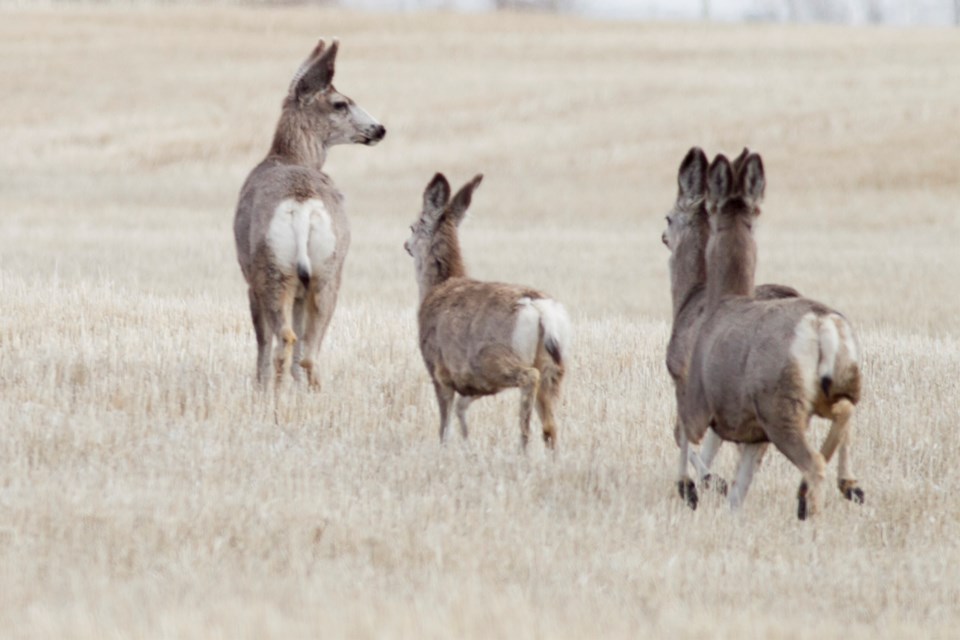SUNDRE – With an uptick in the recent number of wildlife collisions reported to the RCMP, the commander of the local detachment urges motorists not only to drive to conditions but to also be situationally aware of their surroundings.
Over the span of the past several weeks, there have been “lots of deer strikes,” said Sgt. Randy Poon.
Among the most recent such collisions occurred on Friday, Dec. 1 at about 8 a.m., when a GMC pickup driven by a male adolescent accompanied by a female passenger ended up rolled onto its side in a ditch west of the former Bergen Store.
The vehicle’s occupants were later identified as being Austin and Chyanne Nixon, the twin teenagers of MLA Jason Nixon, who later issued a public statement confirming what happened and that Austin was in stable but critical condition after being airlifted by STARS to Calgary Foothills Hospital.
“It appears the rollover may have happened due to a deer running across the road. So, speed was not a factor,” said Poon.
“This is kind of typical around this time of the year around the fall time,” he said on Wednesday, Dec. 6 during a phone interview in response to follow-up questions.
“The deer and animals are more active at around this time, especially on the highways.”
Compounding the situation is the earlier setting sun with a sky that’s largely dark by about 5 p.m. when many people are still at work or on their way home a bit weary from a long shift.
“Honestly, people are – I wouldn’t say speeding – but they’re not quite paying attention on the road as well. Because if you’re driving at night, sometimes folks are tired,” said Poon.
And once it’s dark out, drivers must also contend with next-generation headlights that even on the low-beam setting can be blinding, he said.
“What I’ve noticed too – maybe because I’m getting older – but all these LED headlights, they seem brighter,” he told the Albertan.
“So when you’re passing vehicles, sometimes you get a bit of a (temporary) night blindness,” the sergeant said, adding a person’s eyes must then refocus and readjust.
“At night, I’ll see – and it’s mostly pickups or SUVs – I’ll see them switch from high-beams down to low-beams, and it’s a negligible difference,” he said, attributing that to manufacturers who deliberately design headlights so bright.
Asked what a motorist should do in the event a deer suddenly leaps out in front of their vehicle, he said, “The best thing to do is drive for the conditions; drive for where your headlights can see – don’t overdrive your headlights.”
On a secondary rural highway with a posted speed limit of 90 kilometres per hour (km/h), for example, drivers should be sure to stay within that range, he said, adding there are some who tend to get overconfident and go faster.
“But then you’re kind of driving past what your lights can actually see,” he said.
As for times of day when drivers aren’t as dependent on their headlights – such as sunrise or sunset – the sergeant reiterated the importance of driving more carefully.
“Especially when the sun is setting – your eyes are trying to focus between the sky light where it’s bright, and then the ditches where it’s dark,” he said. “It’s a matter of paying more attention.”
Pressed as to whether motorists should refrain from reactively jerking the steering wheel in a sudden swerving manoeuvre if they’re unable to brake in time, he said, “I’m not going to say don’t swerve or swerve; I’m not going to dictate how people should drive.
“I think they should drive appropriately and then take what emergency measures they deem to be necessary.”
However, the sergeant stressed the importance of situational awareness to know whether swerving might be a safe option given the circumstances.
“And definitely if you have oncoming traffic and a deer jumps up, don’t swerve into the oncoming traffic,” he said, adding that should just be a given.
But every situation is unique, and whereas swerving in one instance would be ill advised, there could also be scenarios in which it’s fully justified.
“There might be a situation where they could have swerved and that would have been a good idea. But again, that means paying attention to oncoming traffic, to what’s on the side of the road, is the road wide enough – all those factors you have to kind of take into account,” he said.
And if despite a diligent driver’s best efforts to brake or otherwise evade a collision fails and they strike an animal, 911 should be called regardless of whether any persons have sustained injuries, he said.
The emergency operator will ask all of those questions and ultimately determine whether for example firefighters or an ambulance crew should be dispatched, he said, adding police in these case are automatically called out.



